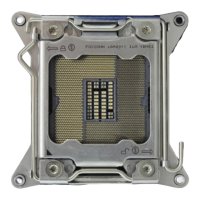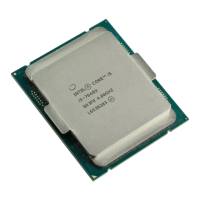Retention Assembly Mechanical Design
Intel
®
Xeon
®
Phi™ Processor x200 Product Family TMSDG Order Number: 334785-002
38
4.3 Heatsink Mechanical Requirements
The mass of the heatsink (HS) should not exceed 600 g. The heatsink mass limit and
the use of a back plate have eliminated the need for Direct Chassis Attach retention in
some implementations. Direct contact between back plate and chassis pan will help
minimize board deflection during shock. Table 4-4 lists heatsink mechanical attributes.
Table 4-4. Heatsink Mechanical Attributes
Attribute Target Comments
Stiffness
1
> 600 lbf/mm
> 1250 lbf/mm
> 1400 lbf/mm
Short span point load
Long span
Short span distributed load
Flatness 0.077 mm (manifesting) Processor local flatness zone in drawing
Base Thickness > 4.5 mm w/ Cu HS base Requires new PHM clip for th
ickness > 4.5 mm
(reference HS base = 4.5 mm)
Static Load (Max) < 300 lbf Thermal validation at 200 lbf shown
Dynamic Load (Max) < 132 lbf Based on 600 g HS. Current HS mass = 424 g
Notes:
1. Heatsinks that do not meet or exceed these stiffness spe
cifications will not be capable of providing the long
term loading that the LGA3647 socket requires. These stiffness specifications are related to socket
reliability; any potential thermal impact due to heatsink base deflection at lower stiffness levels needs to be
determined separately.

